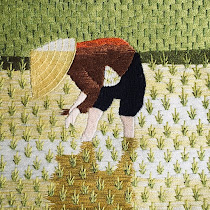A textile from Sapa, Vietnam
It was great to have Helen Barnes back at Harrogate Creative Stitchers today to talk about her travels to Vietnam in the 2000s. She first visited in 2003 with her friend Ruth, a photographer and subsequently went back to visit Vietnam on may occasions as her friend remained there for a decade. So Helen got to know the country really well and its rich and colourful textile heritage. On her first trip, she and Ruth travelled from the south to the north of Vietnam with many meanders and stops along the way over a three week period.
The first slide showed a map of Vietnam and a beautiful illustration
of children riding their bikes to school in their traditional uniform. She reflected that it reminded of her first
visit but that is has changed so much now that motorbikes and cars are more
common place, especially in cities such as Ho Chi Minh, formerly known as
Saigon.
Many of Helen’s photos depicted village life and local scenery such as rice fields and pop-up cafes, each place having its own distinct textiles with different influences. Northern Hmong people’s textiles are very influenced by China for example, because of its proximity and tend to be very colourful and include depictions of dragons. As the country is stretched out from north to south there is a huge variation in climate also. Mountains separate Vietnam from Thailand and Cambodia. There are fifty two cultural groups in Vietnam all with different costumes and distinct design of houses. The Museum of Ethnology in Hanoi is an excellent place to visit regarding this. Another great recommendation from Helen is the Women’s museum displaying many traditional costumes.
Her trip started in the foothills of Saigon near the rainforest
and she showed photos of a local villager weaving a silk scarf. The textiles here are very similar to those
of Thailand and Cambodia. When buying
textiles she spoke of the peoples’ cheerful disposition and their gentle nature
not pushing their goods onto tourists. Helen
was also discerning in what she bought, preferring stitch samples produced by
villagers rather than their special garments or embroideries that may have been
for sale for the right price. She would
visit many villages off the tourist route and many houses were on stilts. She
has also visited Laos and Cambodia, encountering village ladies from Laos who
blacken their teeth, from which she bought a skirt with an interesting method
of joining fabrics to create very strong seams (see below).
Traditional skirt worn by village ladies in Laos
Helen showed us a photo of a villager weaving in her house on stilts next to a tiny window without much light. It showed a loom of red cloth and gold thread. Large pieces of fabric separate their sleeping quarters from the living area. They can incorporate both synthetic fabrics attached to embroidered cloth. They very often ‘mix and match’ fabrics and will often embroider on cloth from disused garments. Stitch and weave normally took place in the afternoon once the village chores were done, creating special pieces such as wedding dowries. Stitch skills are taught at home passed down through the generations. Colours, fabrics, braids and threads would be greatly influenced by the goods on offer at the local markets and it would not be uncommon to find DMC embroidery floss on a market stall!
Helen went on to show us many of the small embroidery samples
that she had picked up on her travels mainly in the northern region by the Hmong
people. Many of the designs have a snail
pattern that we may associate with Thailand. Many are cross stitched on the tiniest
scale using the warp and weft of the fabric.
Another example showed a wax batik design on Indigo dyed cloth (see above) probably from
a garment as the sun has faded the main section and the same retains its colour. Another common design is thick black embroidery
stitches in a motif shape surrounded by white stiches, sometimes in chain. An exquisite indigo dyed cloth coat of hemp purchased
in Saigon but probably made by the Hmong people in the North has the most
beautiful and intricate cross stitch design on the rear of the garment.
In conclusion, Vietnamese textiles are hugely diverse owing to
the country’s geography and proximity to China, Laos, Cambodia and Thailand along
its borders from North to South. This
influences everything from their weaves, cloth, threads, braids, colour and stitch. It was a fascinating talk and wonderful to
see Helen’s beautiful photos of village life and how local textiles form the
fabric of everyday life. Thank you Helen for a beautiful and interesting talk.
.JPG)




.jpg)
.jpg)
.jpg)









Comments
Post a Comment